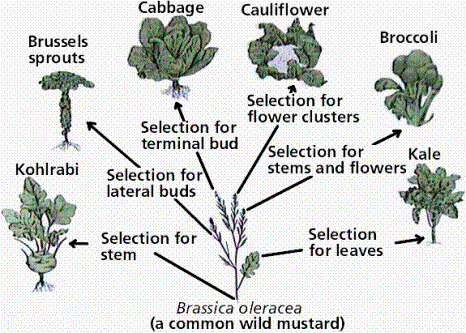
Experience in agriculture shows that monoculture in humans is best avoided
Eugenics, called selective breeding when applied to non-humans, is ubiquitously employed in agriculture with both with plants and animals. Human civilization could not exist without it since the majority of increases in agricultural productivity in human history would otherwise not have happened. In one of the most astounding examples of selective breeding, wild mustard was morphed through human intervention into multiple phenotypically divergent species including cabbage, broccoli, kale, brussel sprouts, and cauliflower. Applying some of the same methods and understanding to human populations holds just as much or more promise.
However, there is a very important lesson that must be taken from our experience with selective breeding in agriculture. There is such a thing as evolved diversity. In some situations natural selection favors differences between individuals and does not converge on a single phenotype. For the genes involved in the immune system and immune responses, natural selection heavily favors hypervariable polymorphism. The reason for this should be obvious, but I will spell it out anyway. Pathogens and parasites engage in an evolutionary arms race with their hosts. Pathogens hinder the fitness of the individuals most vulnerable to them, and allow for resistant individuals to have more children and come to dominate the population. The pathogen must then adapt to the new normal of the population, which causes the process to repeat itself. A population with great diversity in its immune system genes stands a much better chance as a whole against pathogens because it makes it much more difficult for the pathogen to become highly specialized, and thus highly effective, against its host population. Maintaining this genetic diversity is so important, in fact, that the pheromone system developed primarily to preferentially boost attraction for mates with highly contrasting histocompatibility genes.*
In agriculture, there has been a repeated tendency to exclusively grow a single or small number of cultivars with a particularly useful trait or set of traits at the expense of maintaining genetic diversity in the crop population. In plants this can be especially onerous because in many cases it is possible for a plant to reproduce clonally. Propagating a cultivar clonally effectively freezes the evolution of that organism. From the perspective of pathogens this turns a moving target into a sitting duck. Invariably pathogens adapt to be especially virulent to that one strain and the entire crop gets wiped out. This is what caused the great potato famine in Ireland. This is also the reason apples always appear on the top of pesticide contamination lists. Apple trees grown from seeds mostly produce low quality fruits, with appealing fruits being a rare exception. This is because many genes take part in shaping the apple, and most of the allele combinations that result from sexual reproduction and meiosis in apple trees are agriculturally unappealing. Worse yet, years of growth must be allowed for a new tree before it can be known whether the apples it produces will be useful, which causes the costs of apple breeding to be higher than for other plants. When that rare tree with good traits appears, branches are cut from it and grafted onto the trees with unappealing fruit. Once these grafted branches have grown large enough, they can provide new grafts for even more trees which eventually creates a large population of trees producing genetically identical apples. All red delicious apples originate from one individual tree, as do granny smiths and all other apple varieties. Unfortunately, pathogens are well placed to infect these cloned trees and the only way they can be grown effectively is with a large amounts of pesticide. The benefit of providing fresh fruit to the population almost certainly outweighs the costs of consuming small amounts of pesticide. In the worst case scenario a crop is wiped out and certain fruit varieties become unavailable or more expensive. Though problematic, it is tolerable for the benefit received.
However, risking genetic weakness to disease would not be tolerable in human populations; especially considering how most people live in very densely packed areas where the opportunity for disease spread is plentiful. Excessive genetic homogeneity could result in entire cities or regions being wiped out. The number one consideration about the evolutionary direction in any eugenics policy is not increased intelligence, strength, or endurance, but avoiding the complication of increased disease susceptibility. This is why it would be very unwise to be too aggressive in promoting specific alleles or allele combinations. Moderate promotion of the fertility of individuals who express phenotypes with positive effects such as intelligence would be helpful generally, but at no point should it be arranged that single individual or small group become ancestral to too high a fraction of the population. However positive their traits may be, it isn’t worth the disease risk to create too much homogeneity.
* Prevention of inbreeding is another advantage of the pheromone system. Inbreeding can make it more likely to inherit two copies of a recessive allele that causes a genetic disease.
Find other great dissident right content with the two Atavisionary RSS feeds: Atavisions and Prolific Atavisions. In addition, download the free ebook Smart and Sexy to learn what, how and why there are biologically based cognitive differences between the sexes
